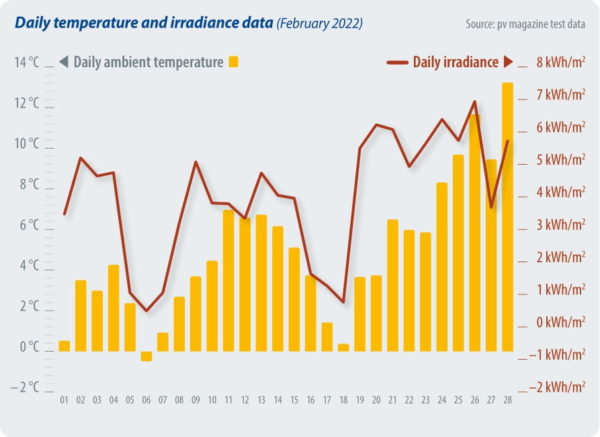The first chart to the right shows the meteo-station data (irradiance and ambient temperature) for February 2022. The average bifacial boost for this period was 5.6%. Bifacial boost is defined as the extra energy yield of the bifacial products compared to the average energy yield of all monofacial mono PERC products.
The chart to the bottom right shows the comparison between different PV module technologies for February 2022. Bifacial modules are steadily performing above all the other technologies, with multicrystalline modules having the lowest yield.
Notes on the energy yield:
- The energy yield comparison among various technologies, including bifacial boost, will be analyzed using products installed after the beginning of 2019.
- The energy yield is given in Wh/Wp and is calculated by dividing the energy produced by the module by the Pmax at STC of the module. This Pmax is the maximum STC power after a process of stabilization.
- The results are grouped into categories, per module type.
- The bifacial boost depends on many parameters: the bifaciality factor, the installation geometry, the albedo of the ground, and the sun angle and diffuse irradiance. The ground in this case is gray gravel.
George Touloupas
| Bifacial boost | ||||
| all in Wh/Wp | Total Nov 2021 | Total Dec 2021 | Total Jan 2022 | Total Feb 2022 |
| Average monthly yield | 36.43 | 91.28 | 71.45 | 103.45 |
| Average monthly bifacial yield | 36.79 | 93.77 | 73.36 | 106.75 |
| Average monthly monofacial Mono PERC yield | 0.00 | 89.61 | 69.90 | 101.08 |
| Operation days | 10 | 30 | 25 | 28 |
| Average daily yield | 3.64 | 3.04 | 2.86 | 3.69 |
| Average daily bifacial yield | 3.68 | 3.13 | 2.93 | 3.81 |
| Average daily monofacial yield | 0.00 | 2.99 | 2.80 | 3.61 |
| Bifacial boost | NA | 4.6% | 5.0% | 5.6% |
| Energy yield ranking | |||||||||||
| # | Installation Month | Product | Type | Total Nov 2021 Wh/Wp | Total Dec 2021 Wh/Wp | Total Jan 2022 Wh/Wp | Total Feb 2022 Wh/Wp | Nov 2021 Rank | Dec 2021 Rank | Jan 2022 Rank | Feb 2022 Rank |
| 26 | 2019/8/28 | LONGi LR6-72HBD375 | Bifacial Mono PERC | 38.2 | 95.5 | 74.44 | 109.357 | 2 | 2 | 2 | 1 |
| 37 | 2021/5/1 | LONGi LR4-72HBD-445M | Bifacial Mono PERC | 38.9 | 96.9 | 75.48 | 108.315 | 1 | 1 | 1 | 2 |
| 27 | 2019/12/31 | Jolywood JW-D72N-400 | Bifacial Mono N-TOPCon | 37.6 | 93.6 | 73.64 | 107.248 | 3 | 4 | 3 | 3 |
| 34* | 2021/7/1 | JA JAM72D20-445MB | Bifacial Mono PERC | 33.0 | 93.7 | 73.07 | 106.530 | 8 | 3 | 5 | 4 |
| 38 | 2021/11/20 | LONGi LR5-72HBD-535M | Bifacial Mono PERC | 37.2 | 93.1 | 73.22 | 106.222 | 4 | 5 | 4 | 5 |
| 28 | 2020/4/15 | Risen RSM114-6-405BMDG | Bifacial Mono PERC | 36.9 | 91.9 | 71.76 | 104.861 | 5 | 7 | 7 | 6 |
| 32 | 2021/7/1 | Risen RSM150-8-500BMDG | Bifacial Mono PERC | 35.7 | 91.6 | 71.94 | 104.735 | 6 | 8 | 6 | 7 |
| 35* | 2021/7/1 | JA JAM72S20-445MR | Mono PERC | 89.4 | 70.44 | 102.956 | 13 | 11 | 8 | ||
| 20 | 2018/11/21 | Phono PS380MH-24/TH | Mono PERC | 91.1 | 70.83 | 101.968 | 9 | 8 | 9 | ||
| 36 | 2021/11/20 | JA JAM72S30-540MR | Mono PERC | – | 89.8 | 70.18 | 101.497 | – | 11 | 12 | 10 |
| 31* | 2020/10/1 | JA JAM60S10-345/MR | Mono PERC | 92.1 | 70.67 | 101.215 | 6 | 9 | 11 | ||
| 40* | 2021/11/20 | Trina TSM-505DE18M(II) | Mono PERC | – | 87.9 | 69.25 | 100.718 | – | 16 | 17 | 12 |
| 30 | 2020/7/7 | GCL GCL-M3/72H380 | Cast Mono PERC | 89.6 | 69.71 | 100.460 | 12 | 14 | 13 | ||
| 21 | 2019/3/1 | Risen RSM120-6-320M | Mono PERC | 89.2 | 69.97 | 100.308 | 14 | 13 | 14 | ||
| 29* | 2020/7/7 | CSI CS3U-390MS | Mono PERC | 90.4 | 69.4 | 100.067 | 10 | 15 | 15 | ||
| 33* | 2021/7/1 | Trina TSM-450DE173(II) | Mono PERC | 87.0 | 68.47 | 99.892 | 18 | 18 | 16 | ||
| 10 | 2018/5/24 | Recom RCM-275-6MB-4-BB21 | Mono | 88.2 | 70.55 | 98.685 | 15 | 10 | 17 | ||
| 22 | 2019/5/4 | Znshine ZXP6-60-275/P | Multi | 87.3 | 69.37 | 97.386 | 17 | 16 | 18 | ||
| *Purchased products from the market, which bypassed the random sampling process. The rest of the products were provided by the suppliers. | |||||||||||



Test cooperation
pv magazine test is a cooperative effort involving pv magazine, APsystems, CEA and Gsolar. All testing procedures are carried out at Gsolar’s test laboratory in Xi’an, China. CEA supervises these tests and designed both the indoor and outdoor testing procedures.
This content is protected by copyright and may not be reused. If you want to cooperate with us and would like to reuse some of our content, please contact: editors@pv-magazine.com.